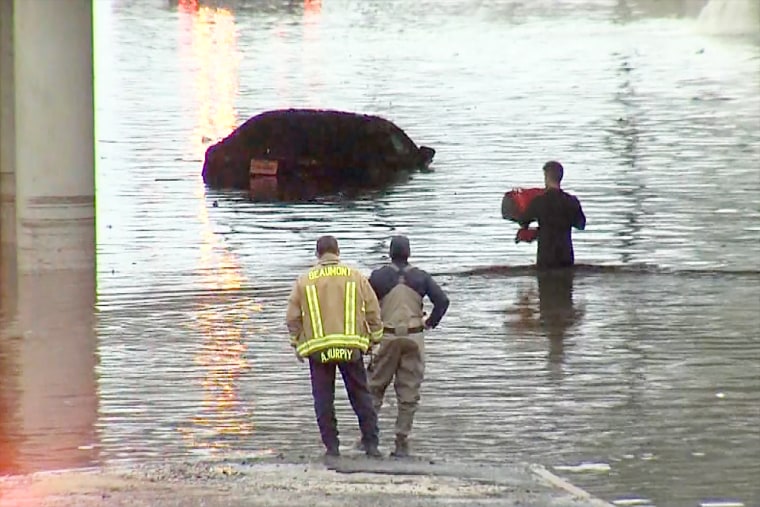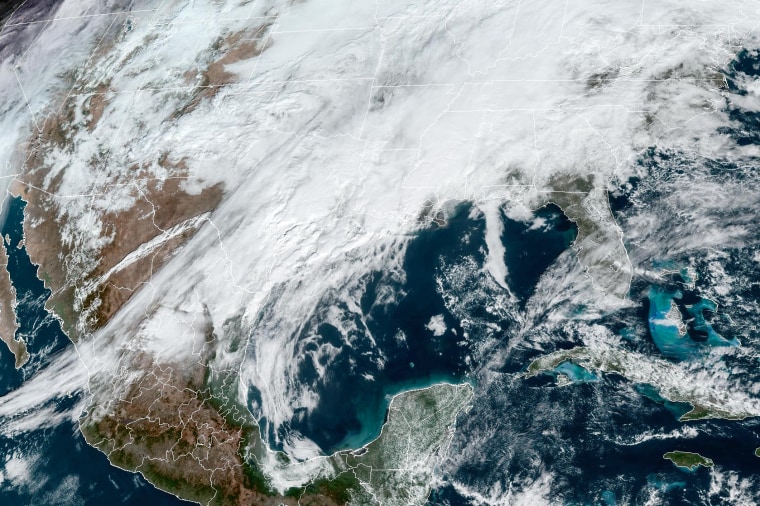A disaster declaration was issued in southeastern Texas and cars became trapped in floodwaters in Louisiana as heavy rain soaked parts of the South on Wednesday, leaving millions of people there under alerts and warnings, officials said.
In San Jacinto County, where top executive Judge Fritz Faulkner issued the disaster declaration, residents below the Lake Livingston Dam were urged to voluntarily evacuate.
County emergency officials cited “imminent danger of high rising water from the river.”

More than 38 million people were under flood watches and another 2 million were under flood warnings Wednesday evening, according to the National Weather Service, mostly in a swath of the country from Texas to Georgia and Tennessee.
A flash flood emergency was declared in St. Tammany Parish, Louisiana, where images shared by the weather service showed flooded streets and cars.
“Cars have stalled and drove off the roads. We have received so much rain in a short period of time. Stay off the roads if possible!” the parish, on the north shore of Lake Pontchartrain, warned.
The threat of flash floods could extend into Thursday.
Forecasters warned that localized double-digit rainfall totals in the 10-12 inch range were also not out of the question, especially after a second drenching of rain occurs during the day Thursday.
A little over 10 inches of rain fell in Industry, Texas, and around 5 to 6 inches fell in parts of Brazos County as of around 9:30 a.m. Wednesday, according to the weather service.

These significant rainfall rates, combined with an already saturated ground, will create the risk for deadly flash flood conditions. Water rushing over roadways could sweep away cars and could be difficult to spot if the flooding occurs during nighttime.
The weather service in Houston, where there was a flood watch until noon Thursday, warned of additional rain through Thursday morning.
An additional 2 to 4 inches was forecast across southeast Texas and central Louisiana Wednesday night, according to the weather service in Lake Charles, Louisiana. Southwest Louisiana was forecast for a possible additional 4 to 6 inches.
In addition to urban flash flooding, river flooding was a concern, especially along major rivers such as the Trinity, San Jacinto and Navidad in southeastern Texas, all of which are expected to rise to a major flood stage.
In Montgomery County, Texas, which is north of Houston, firefighters on Wednesday brought 17 people and and 15 pets to safety as the swollen San Jacinto River caused flooding, the fire department there said.
The San Jacinto River near Humble, which is just south of the county, was at minor flood stage late Wednesday and was forecast to crest at 51.8 feet, which is a moderate stage, on Friday, according to the weather service.
The combination of gusty winds and flooding could create a risk for downed trees and power lines, so officials stressed the importance of staying away from downed power lines and staying out of any water near them, as electrocution can occur.
Another round of rain will develop over eastern Louisiana and Mississippi by Friday morning. Rain through Friday will range from 1 to 5 inches, with Louisiana and Mississippi getting the higher end of that range.
On Thursday, damaging wind could be a concern in Baton Rouge and New Orleans in Louisiana and Birmingham in Alabama.
The recent rounds of rain are part of an active weather pattern affecting much of the eastern half of the contiguous U.S. As the southern tier gets soaked, the northern tier from the Midwest and the Great Lakes to the Northeast and New England has been dealing with messy rounds of wintry precipitation, including a mix of freezing rain and snow.


